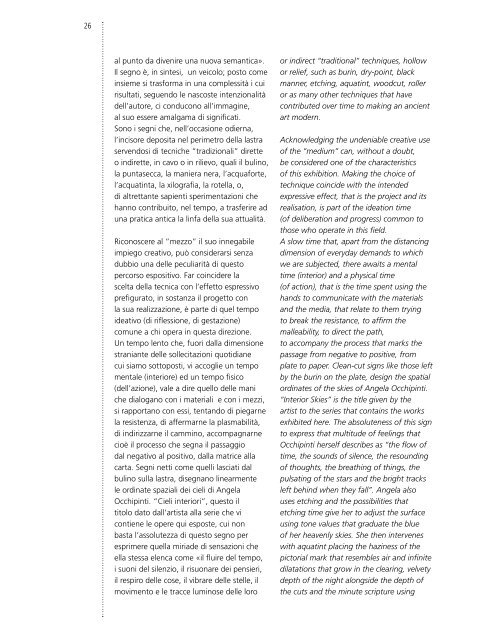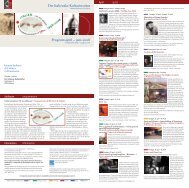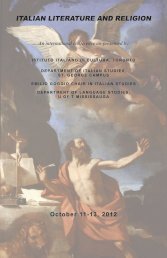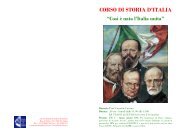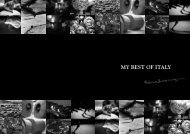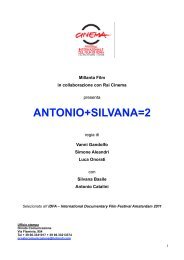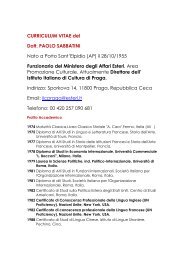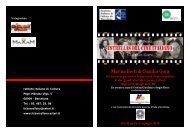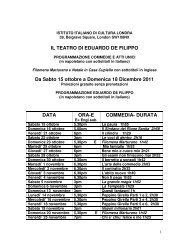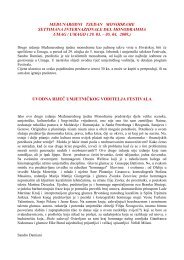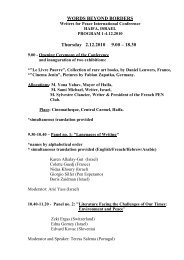Untitled - Ministero degli Affari Esteri
Untitled - Ministero degli Affari Esteri
Untitled - Ministero degli Affari Esteri
You also want an ePaper? Increase the reach of your titles
YUMPU automatically turns print PDFs into web optimized ePapers that Google loves.
26<br />
al punto da divenire una nuova semantica».<br />
Il segno è, in sintesi, un veicolo; posto come<br />
insieme si trasforma in una complessità i cui<br />
risultati, seguendo le nascoste intenzionalità<br />
dell’autore, ci conducono all’immagine,<br />
al suo essere amalgama di significati.<br />
Sono i segni che, nell’occasione odierna,<br />
l’incisore deposita nel perimetro della lastra<br />
servendosi di tecniche “tradizionali” dirette<br />
o indirette, in cavo o in rilievo, quali il bulino,<br />
la puntasecca, la maniera nera, l’acquaforte,<br />
l’acquatinta, la xilografia, la rotella, o,<br />
di altrettante sapienti sperimentazioni che<br />
hanno contribuito, nel tempo, a trasferire ad<br />
una pratica antica la linfa della sua attualità.<br />
Riconoscere al “mezzo” il suo innegabile<br />
impiego creativo, può considerarsi senza<br />
dubbio una delle peculiarità di questo<br />
percorso espositivo. Far coincidere la<br />
scelta della tecnica con l’effetto espressivo<br />
prefigurato, in sostanza il progetto con<br />
la sua realizzazione, è parte di quel tempo<br />
ideativo (di riflessione, di gestazione)<br />
comune a chi opera in questa direzione.<br />
Un tempo lento che, fuori dalla dimensione<br />
straniante delle sollecitazioni quotidiane<br />
cui siamo sottoposti, vi accoglie un tempo<br />
mentale (interiore) ed un tempo fisico<br />
(dell’azione), vale a dire quello delle mani<br />
che dialogano con i materiali e con i mezzi,<br />
si rapportano con essi, tentando di piegarne<br />
la resistenza, di affermarne la plasmabilità,<br />
di indirizzarne il cammino, accompagnarne<br />
cioè il processo che segna il passaggio<br />
dal negativo al positivo, dalla matrice alla<br />
carta. Segni netti come quelli lasciati dal<br />
bulino sulla lastra, disegnano linearmente<br />
le ordinate spaziali dei cieli di Angela<br />
Occhipinti. “Cieli interiori”, questo il<br />
titolo dato dall’artista alla serie che vi<br />
contiene le opere qui esposte, cui non<br />
basta l’assolutezza di questo segno per<br />
esprimere quella miriade di sensazioni che<br />
ella stessa elenca come «il fluire del tempo,<br />
i suoni del silenzio, il risuonare dei pensieri,<br />
il respiro delle cose, il vibrare delle stelle, il<br />
movimento e le tracce luminose delle loro<br />
or indirect “traditional” techniques, hollow<br />
or relief, such as burin, dry-point, black<br />
manner, etching, aquatint, woodcut, roller<br />
or as many other techniques that have<br />
contributed over time to making an ancient<br />
art modern.<br />
Acknowledging the undeniable creative use<br />
of the “medium” can, without a doubt,<br />
be considered one of the characteristics<br />
of this exhibition. Making the choice of<br />
technique coincide with the intended<br />
expressive effect, that is the project and its<br />
realisation, is part of the ideation time<br />
(of deliberation and progress) common to<br />
those who operate in this field.<br />
A slow time that, apart from the distancing<br />
dimension of everyday demands to which<br />
we are subjected, there awaits a mental<br />
time (interior) and a physical time<br />
(of action), that is the time spent using the<br />
hands to communicate with the materials<br />
and the media, that relate to them trying<br />
to break the resistance, to affirm the<br />
malleability, to direct the path,<br />
to accompany the process that marks the<br />
passage from negative to positive, from<br />
plate to paper. Clean-cut signs like those left<br />
by the burin on the plate, design the spatial<br />
ordinates of the skies of Angela Occhipinti.<br />
“Interior Skies” is the title given by the<br />
artist to the series that contains the works<br />
exhibited here. The absoluteness of this sign<br />
to express that multitude of feelings that<br />
Occhipinti herself describes as “the flow of<br />
time, the sounds of silence, the resounding<br />
of thoughts, the breathing of things, the<br />
pulsating of the stars and the bright tracks<br />
left behind when they fall”. Angela also<br />
uses etching and the possibilities that<br />
etching time give her to adjust the surface<br />
using tone values that graduate the blue<br />
of her heavenly skies. She then intervenes<br />
with aquatint placing the haziness of the<br />
pictorial mark that resembles air and infinite<br />
dilatations that grow in the clearing, velvety<br />
depth of the night alongside the depth of<br />
the cuts and the minute scripture using


